Kate Rauner's Blog, page 70
July 30, 2016
Ultimate Geologic Hazard – Supervolcano #science #geology #volcano #supervolcano #disaster
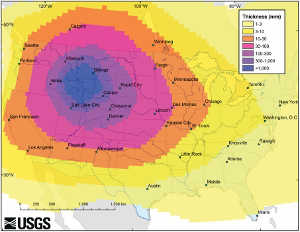
From USGS – this is not going to happen in our lifetimes – not even close
Supervolcanoes have repeatedly carved Earth’s landscape and bioscape over the eons. Almost two dozen of these monsters are scattered across the Earth today, recharging magma and gases, waiting to erupt again when they grow big enough. They’re sleeping giants that blow once every 100,000 years on average.
But that’s not a very precise forecast.
A study of the beautiful crystal patterns from past eruptions suggests these volcanoes will give us a warning.
Just before the magma breaches the overlying rock in an eruption, there will be an accelerating drop in pressure as dissolved gas begins escaping from the liquid magma… from the end of the chamber’s recharge period to the point of eruption, no more than a year of time passes.” iflscience.com
Imagine the US government announcing that Yellowstone will erupt within the next year. Geologists would probably offer a range of times – suppose they said that between six and eighteen months from now, hundreds of cubic miles of rock, dust, and volcanic ash will be ejected into the sky.
Imagine a circle about 500 miles (800 kilometers) across surrounding Yellowstone; studies suggest the region inside this circle might see more than 4 inches (10 centimeters) of ash… The ash would be pretty devastating for the United States, scientists predict. The fallout would include short-term destruction of Midwest agriculture, and rivers and streams would be clogged by gray muck. livescience.com
Suppose the government told everyone from the West Coast all the way east to Chicago they should get ready for ash-fall. But those aren’t the people in the greatest danger. Within that circle is a more deadly area ranging from Missoula, Montana to Denver, Colorado, including Boise, Billings, Casper, Rapid City, Cheyenne, and Salt Lake City.
Suppose the government said that, within this kill-zone, you all must leave. It’s possible you’ll never return. Your homes, businesses, and everything you leave behind will be worthless, destroyed under ash. Imagine ten or twenty million people about to join 100 million in that wider ash-fall range under many inches of ash.
Would anyone believe the predictions? Would anyone evacuate? Should people be forced to leave? Would the “safe” Atlantic Coast or northeast Canada be willing or able to absorb the refugees? What would happen as everyone sat – waiting – waiting for weeks or months – as geologists posted pressure readings? Should we spend money planning for such a cataclysmic event, and if we should, how much money should we spend?
Fortunately for America, the answer is – no, don’t worry about Yellowstone. It seems far from an eruption, and you can follow the Yellowstone supervolcano at volcanoes.usgs.gov. But the rest of the world may not be as lucky with their sleeping giants.
I’ve rhymed about supervolcanoes in one of my most popular poems – Because They’re Big. Own that

More science-inspired poems i includes the popular Because They’re Big super-volcano poem
poem and more in Rhyme and Reason Two (on Amazon, B&N, Apple iTunes, Kobo, and other on-line retailers.)
Thanks to iflscience.com and a new study in PLOS ONE, the analysis of an ancient supereruption in eastern California.
Filed under: Neat Science News Tagged: doomsday, eruption, magma, one year warning, poem, poetry, supervolcano, Yellowstone








July 27, 2016
Star Sugars #poem #space #star #chemistry #poetry
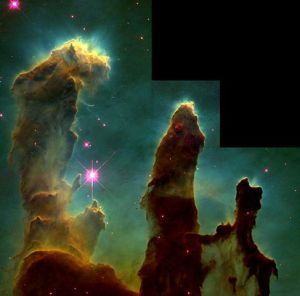
Pillars of Creation, a famous stellar nursery
Via photosynthesis,
Plants store solar energy
In hydrated aldehydes,
Organics formed so cleverly.
Add nitrogen or phosphorus
For an acidic amide,
Defining protein molecules,
Solvents, enzymes, muscles, hide.
So why do interstellar clouds
Contain organic molecules,
Ubiquitous in dusty space
Where life can hardly be the rule?
There is compelling evidence,
Despite cold in extremity,
That cosmic rays are driving
An out-of-balance chemistry.
Unborn stars and planets,
Laced with heavy elements
Are interstellar nurseries
For compounds biorelevant.
By Kate Rauner
Thanks to http://www.pnas.org/content/113/28/7727 and A study of interstellar aldehydes and enols as tracers of a cosmic ray-driven nonequilibrium synthesis of complex organic molecules
Filed under: Poetry Tagged: astrochemistry, cosmic rays, poem, poetry, space, star, stellar nurseries, where do organic molecules come from








July 23, 2016
Does Reality Matter? #reality #science #politics #dnc #rnc #reason
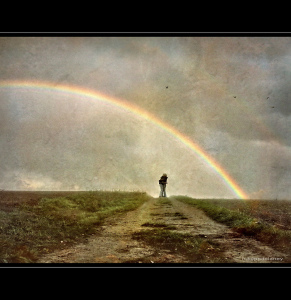
Hartwig HKD
I usually stay away from politics on this blog, but America’s two major political parties have their conventions in July so it’s hard to resist. The Republicans are done and the Democrats are about to begin. Conventions are an opportunity to revel in the echo chamber, to be surrounded by those who agree with you.
And to ignore facts in favor of politics.
I was reminded of that by a piece in Live Science. This article fact-checks truthiness in the Republican platform but I don’t doubt you’ll find similar fabrications when the Democrats issue their platform. It seems that anyone zealously bound to a position is immune to information. Each extreme dismisses different facts, but they both do it.
Even a depressing reality is better than a fantasy however pleasant, because reality wins in the end. I try to read multiple opinions and fact-checks, and to be ready to change my mind. It takes conscious effort.
Once a human being embraces a position, proofs and facts are abandoned, and showing a person contradictory facts just makes them more angry and more determined to dig in deeper.
That’s because we are each grounded in moral foundations deeply important to our vision of who we are – more important than any fact.
Friendly relations, commonality, and trust make it easier for people to listen to each other. More important than presenting facts is establishing bonds with people before you try to convince them. Try it. You might both see the issue in a new light.
I read a book with insight to this aspect of human behavior and reviewed it here for a friend’s blog. I also posted a piece on how to talk with people who disagree with you: Don’t be a jerk.
Keep in mind what Carl Sagan said:
In science it often happens that scientists say, ‘You know that’s a really good argument; my position is mistaken,’ and then they would actually change their minds and you never hear that old view from them again. They really do it. It doesn’t happen as often as it should, because scientists are human and change is sometimes painful. But it happens every day. I cannot recall the last time something like that happened in politics or religion.
This is why science inspires me and also why I’m optimistic about the future. Let your open heart lead to an open mind and we can build a better world.
Filed under: Neat Science News Tagged: fact check, facts, Fantasy, moral foundation, optimism, politics, Reality, religion, science, truth, truthiness








July 20, 2016
We Mocks Ur Gravity #cute #cat #poem #poetry #cats #haiku
All kittens can fly
Gravity waits patiently
Till they’re old and fat

https://creativecommons.org/licenses/by-nd/2.0/
Filed under: Poetry Tagged: cute cat, haiku, kitten, nature, poem, poetry








July 16, 2016
We Can Do Good #nature #environment #southpole #CFCs #Ozonehole
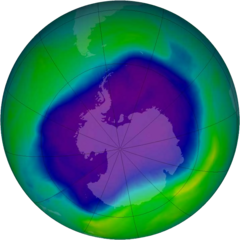 Thirty years ago, scientists realized that chemicals – chlorofluorocarbons or CFCs – were accumulating high in the atmosphere. CFCs are wonderfully inert around humans and were widely used as propellants in spray bottles and fluids in refrigerators. But in the upper atmosphere they reacted with nature’s ozone to destroy the chemical that reduces dangerous UV radiation arriving from space.
Thirty years ago, scientists realized that chemicals – chlorofluorocarbons or CFCs – were accumulating high in the atmosphere. CFCs are wonderfully inert around humans and were widely used as propellants in spray bottles and fluids in refrigerators. But in the upper atmosphere they reacted with nature’s ozone to destroy the chemical that reduces dangerous UV radiation arriving from space.
In 1974, Mario Molina and Sherwood Rowland, two chemists at the University of California, Irvine, published an article in Nature detailing the threats to the ozone layer from chlorofluorocarbon (CFC) gases. At the time, CFCs were commonly used in spray bottles and as coolants in many refrigerators, and they were rapidly accumulating in the atmosphere.
Eleven years later, their predictions were confirmed – the ozone hole was allowing extra UV radiation to hit Earth’s surface and increase skin cancer rates.
The groundbreaking research—for which they were awarded the 1995 Nobel Prize in chemistry—concluded that the atmosphere only had a “finite capacity for absorbing chlorine” atoms in the stratosphere.
We can do good!
I hope this heartens people who say we humans can’t repair the damage we do. Scientific models proved correct. We can discover a problem and work internationally on a solution! Ozone is one example.
As one researcher said, “It gives us hope that we shouldn’t be afraid to tackle large environmental problems.”
Thanks to nationalgeographic.com for the quote above. Other outlets are covering the good news, too.
Filed under: Neat Science News Tagged: atmospheric science, CFCs, hydrofluocarbons, ozone hole, south pole








July 13, 2016
Mars-ward Ho #space #science #explore #Mars #tech @MarsOneProject #SpaceX
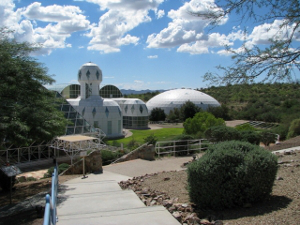
in the 1990s, Biosphere 2 studied a closed system similar to what Mars colonists may need to create
Orbiting the planet,
above Viking’s bones,
Odyssey’s a switchboard
that seeks new landing zones.
Global Mars Surveyor
measures gravity,
Magnetosphere, minerals,
and topography.
MAVEN and Mangalyaan
sniff at the Martian air,
Japan will gather samples
and bring them back from there.
Joining Opportunity
in studying the rocks,
Rover Curiosity
seeks life’s building blocks.
UAE will gather data
on the frigid dry climate.
China’s rover should be very good
at biotech.
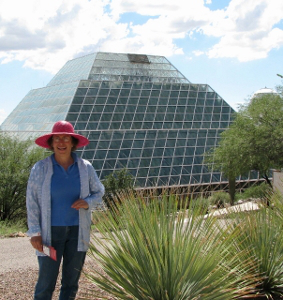
Yup, that’s me at Biosphere 2
Sands of a planet solely occupied
by robots,
Soon will carry boot-prints from
eager astronauts.
Far beyond horizons
where ancestors have roamed,
Mars One and SpaceX
want to claim Mars as a home.
By Kate Rauner
The list of missions to Mars – failed and successful – is long, but the list of planned missions is growing longer. Thanks to space.com for the update. You can visit Biosphere 2 in Arizona where environmental studies are ongoing.
Visit Mars yourself, in my science fiction series On Mars.
Filed under: Neat Science News, Poetry Tagged: citizen scientist, colonize, colony, exploration, Mars One, Missions to Mars, NASA, planet, poem, poetry, solar system, spacefaring, SpaceX








July 9, 2016
Light and Dark Play Role in Life #science #nature #tree #GreatBritian

European Ash flowers
Humans are diurnal creatures and we carry light into darkness. In my area of New Mexico, where astronomers can still find dark skies, the fight against badly-designed artificial lights is on-going. But, while artificial light can disturb human sleep cycles, it’s generally a good thing for us. That’s not true for all animals. And now a study shows it affects plants, too.
You may know that artificial lights change the behavior of bats and sea turtles, but trees in cities are leafing out earlier thanks to night-time light. Scientists in the UK collected citizen observations of nearly 42,000 individual trees of four species, and satellite data on light intensity. After controlling for temperature and urban heat-trapping, they found three of the tree species budded earlier when exposed to nighttime lights.
It’s not clear whether this change hurts or helps other creatures, but it’s a fascinating study.
Thanks to researcher Richard ffrench-Constant, an etymologist at the University of Exeter, and livescience.com
Filed under: Neat Science News Tagged: artificial light, citizen scientist, etymology, spring in UK Great Britain, University of Exeter, when do trees bud in spring








July 6, 2016
Mars’ Lost Chance #Mars #science #space #solarsystem #poem #poetry #planet
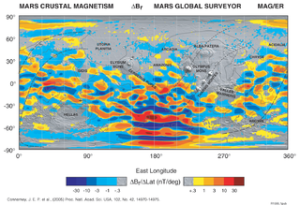
Fractured remnants of Mars’ magnetic field mapped by NASA
A shallow sea that shimmered
Beneath a sky of blue,
As promising a planet
As any that Life knew.
A passing asteroid
Sheared off it’s northern pole,
Set Mars on a course
To barren, dry, and cold.
It ruined north-south symmetry,
The planet’s never healed.
Destroyed surface protection
By its magnetic field.
Solar winds bombarded,
Air slowly was devoured
By protons and electrons
At a million miles an hour.
Mars clutched at its air with gravity,
But that was not enough.
Its magnetosphere was shattered
And its molten core rebuffed.
A friendly little planet
That could have been a home
To our cosmic brethren
Has left us on our own.
By Kate Rauner
Thanks to planetary.org’s emily lakdawalla
Filed under: Poetry Tagged: atmosphere, magnetic field, mars, NASA, planetary impact, poem, poetry, why is Mars northern hemisphere so different








July 4, 2016
Witness Most Intimate #FourthofJuly #HappyFourthofJuly #American #history #science #archeology #USA
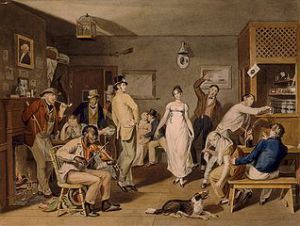
Dancing in a tavern of the 1800s
It saw the Colonies
Become United States,
Saw hostilities
Building as storm clouds,
Heard the Independence
Declaration read out loud
Captured Chinese porcelain,
Some German tankards, too,
Fragments of a window pane,
And bottles that held brew.
Heard revolution planned
By drunken
Patriots,
Wondered if the wine and beer
Gave the outcome
That they got.
Held punch bowls and glasses,
Smoking pipes and dishes,
And bottles, bottles, bottles
For every drinker’s wishes.
Served men and fallen ladies,
It was the privy pit
Of an illegal tavern,
A Revolution’s toilet.
By Kate Rauner and first posted – you guessed it – on July 4th. I’m posting early because we’re headed to our small-town parade which starts at 10 am. July is the start of the monsoon rains in New Mexico and the afternoon will either be too hot (rains not here yet) or too stormy (but people who live in a desert never complain about rain) for parades.
Thanks to nationalgeographic.com and archaeologists digging on the future site of Philadelphia’s Museum of the American Revolution.
Filed under: Poetry Tagged: 4th of July, American history, American Revolution, archeology, colonial history, Fourth of July, Museum of the American Revolution, Philadelphia, pit latrince, pit toilet








July 2, 2016
Europa-Best Chance to Find ET Life and Congress Says We Gotta Go #NASA #science #tech #solarsystem
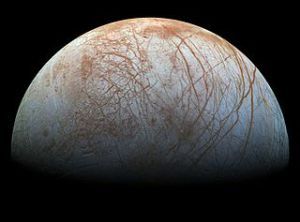 Who says Congress can’t get anything done? They’ve told NASA “you gotta go,” could be as soon as 2022. Jupiter’s gravitational flexing generates a lot of heat inside the moon – enough for a 150 km deep water ocean to exist under the ice crust.
Who says Congress can’t get anything done? They’ve told NASA “you gotta go,” could be as soon as 2022. Jupiter’s gravitational flexing generates a lot of heat inside the moon – enough for a 150 km deep water ocean to exist under the ice crust.
What’s more, rusty colored stains on the ice around the cracks suggest that the water is heavy in salts and minerals. Chemistry plus energy plus time—all of which Europa has in the right mix—may be all that is necessary to cook up life…
[A lander’s] ultimate goal would be to peer directly into the calmer waters of the ocean and perhaps even go swimming.
Congress is a blunt instrument, so I hope their requirements don’t hurt the mission. NASA still has problems to solve. But I can’t wait to find out what’s swimming in Europa’s seas.
Thanks to time.com for the article and quote.
Filed under: Neat Science News Tagged: Europa, exploration, explore, extraterrestrial life, Jupiter, NASA, solar system, spacecraft












